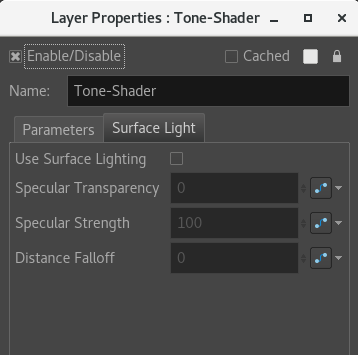The Tone Shader node lets you adjust the tone parameters, such as the colour, to create the desired ambiance. You can animate most parameters over time to create shade transitions. The beveling height and smoothing is set in the Normal Map node.

Tone Shader Properties - Parameters tab
The Parameters tab can be used for both Light Shading and Surface Shading features.

| Parameter | Description |
|
Enable/Disable |
Allows you to enable or disable the node. When disabled, a node has no visible effect on the rendered image, nor on the preview in the Camera, Perspective, Side and Top views. |
|
Colour Swatch |
Sets the colour of the layer in the Timeline view and of the node in the Node view. |
| Name | Allows you to change the name given to the node. |
| Light | |
| Light Type |
Directional: A light that is parallel in the scene. Each “beam” of light follows the direction defined by the light source and target, and point in the same direction. This type of light is used when the light source is far away or very big, like the sun. Point: A light that illuminates everything around it. Its “beam” of light will go in all directions like a fire. Spot: A light that forms a conical shape like a flashlight. |
| Cone Angle |
The value that defines the light’s cone angle. This option is only accessible with the Light Type set to Spot. |
| Diffusion |
Lets you play with the diffusion of the light on the surface of the drawing. In other words, it is the edge softness. This option is only accessible with the Light Type set to Spot. |
| Light Source Elevation |
Defines the height of the spotlight. This option is only accessible when the Light Type set to Spot or Point. |
| Shading Type |
Smooth: The light and tone fx will have smooth edges. Sharp: The light and tone fx will have sharp edges. |
| Bias |
Define the polarization of the light. When the Shade type is set to Smooth, it defines the width of the light’s smooth zone. When the Shade type is set to Sharp, the Bias defines the antialiasing on the edge of the hightlight or tone zone. But,if the Shade type is set to Sharp, the Bias option need a small value such as 0.1 or 0.2. The exponent will be able to compensate the limitation of this small value. |
| Abruptness |
This is a multiplier value of the Bias option. It will define how quick the polarization of the light will change from a value to another. |
| Adjust Light Intensity |
Lets you adjust the light intensity. |
| Intensity |
Lets you set the strength of the light. |
| Multiplier |
Multiplies the value of the Intensity option. |
| Surface Reflectivity |
This option is useful for exaggerating the light on the edge of the 3D geometry. The closer an edge is to the light source, the more intense the light will be. |
| Colour | |
| Red/Green/Blue/Alpha |
The colour and transparency of the Colour Card. You can also attach these parameters to function columns to change their values over time. Click the colour swatch to open the Colour Picker window and select a colour. |
| Colour Swatch |
Opens the Colour Picker window in which you can specify the colour. |
| Use Image Colour |
Lets you use the colour of the drawing in a lighter or darker colour for the highlight and tone fx. |
| Image Colour Intensity |
Lets you blend the colour of the light with the image colour. |
| Flatten Fx |
This is useful when there are several highlight and tone fx, one over the other, but are supposed to be merged together. Sometimes, shadows and lights look better when they do not overlap. |
Tone Share Properties - Surface Light tab
The Surface Light tab can be used only with the Surface Shading feature, therefore it should be ignored when using the Light Shading feature.

| Parameter | Description |
|
Use Surface Light |
Checking the Use Surface Lighting will have the Light Shader node/Tone Shader node consider the Surface depth when rendering the Light/Tone. The specular detail and falloff is only available when this property is enabled. |
|
Specular Transparency |
The Specular Transparency property defines the opacity of the specular highlight. A higher value will make the specular more visible and a lower value will have the specular blend into the diffuse. |
|
Specular Strength |
The Specular Strength defines the sharpness of the highlight. A higher value results in a more defined, sharper highlight, a lower value results in a more diffused render. |
|
Distance Falloff |
The Distance Falloff is a percentage value defining the amount of light that falls off between the Light Position’s source and the Light Position’s target. A value of 0 will result in a render in which the light has no falloff and remains consistent between the source and the target. |